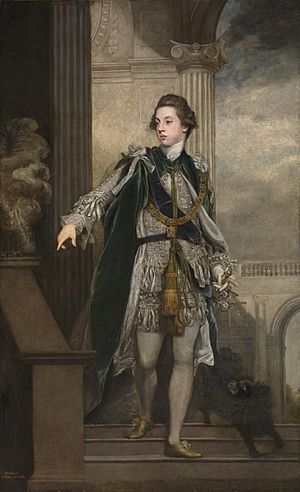Frederick Howard, 5th Earl of Carlisle facts for kids
Quick facts for kids
The Earl of Carlisle
|
|
|---|---|

Portrait by George Romney
|
|
| First Lord of Trade | |
| In office 6 November 1779 – 9 December 1780 |
|
| Monarch | George III |
| Prime Minister | Lord North |
| Preceded by | Lord George Sackville-Germain |
| Succeeded by | The Lord Grantham |
| Personal details | |
| Born | 28 May 1748 |
| Died | 4 September 1825 (aged 77) |
| Spouse | Lady Margaret Caroline Leveson-Gower |
| Children | 10 |
| Parents | Henry Howard, 4th Earl of Carlisle Isabella Byron |
Frederick Howard, 5th Earl of Carlisle (born May 28, 1748 – died September 4, 1825) was an important British nobleman, politician, and writer. He held several key positions in the British government during a time of big changes, including the American War of Independence.
Contents
A Young Leader's Journey
Frederick Howard was the son of Henry Howard, 4th Earl of Carlisle. His mother, Isabella Byron, was related to the famous poet Lord Byron. In fact, Frederick later became Lord Byron's guardian.
When he was younger, Frederick was known for enjoying life and fashion. He became a Knight of the Thistle in 1767. This was a special honor given by the King. In 1770, he joined the House of Lords, which is part of the British Parliament.
Working for Peace
When Frederick was around 30 years old, he was chosen for an important job. He joined a group called the "Carlisle Commission." Their mission was to try and make peace with the Thirteen Colonies during the American War of Independence. Even though the mission didn't succeed, people saw that Frederick was very capable.
Leading in Ireland
Because of his skills, Frederick was given an even bigger role in 1780. He became the Viceroy of Ireland. This meant he was the King's main representative there. It was a challenging time because of the ongoing war. Many regular soldiers had left Ireland, and groups of volunteers had formed.
Despite these difficulties, Frederick's two years in Ireland were peaceful and successful. He helped create a national bank and introduced other measures. These changes had a lasting positive effect on Ireland's trade and economy.
Later Political Life
In 1789, Frederick played a big part in discussions about who would rule if the King became unable to. He supported the Prince of Wales.
Later, in 1791, he disagreed with the government's plan to stop Russia from taking parts of the Ottoman Empire. However, when the French Revolution began, he changed his mind. He strongly supported going to war against France. He even gave up his title as a Knight of the Thistle and became a Knight of the Garter in 1793. This was another very high honor.
Frederick mostly retired from public life after 1815. He did oppose the "Corn Laws" that year, which were laws about grain prices.
In 1798, he was part of a group that bought a large collection of famous paintings. These paintings were then kept at Castle Howard, his family's home.
Family Life
On March 22, 1770, Frederick married Lady Margaret Caroline Leveson-Gower. She was the daughter of a powerful nobleman.
Frederick and Margaret had ten children:
- Lady Isabella Caroline Howard (1771–1848)
- George Howard, who became the 6th Earl of Carlisle (1773–1848)
- Lady Charlotte Howard (1774–1774)
- Lady Susan Maria Howard (1776–1783)
- Lady Louisa Howard (1778–1781)
- Lady Elizabeth Howard (1780–1825)
- William Howard (1781–1843), who became a Member of Parliament
- Lady Gertrude Howard (1783–1870)
- Major Frederick Howard (1785–1815), who sadly died in battle at Waterloo
- Henry Edward John Howard (1795–1868)
Frederick Howard is also thought to be the father of Howard Staunton (1810–1874). Staunton became a very famous English chess master. Many people considered him the strongest chess player in the world from 1843 to 1851.
His Writings
Frederick Howard was also a writer. He wrote several political essays, many poems, and two plays.
Some of his works include:
- Poems (1773)
- The Father's Revenge (a play, 1783)
- To Sir J. Reynolds (poems, 1790)
- A Letter to Earl FitzWilliam (1795)
- The Crisis (1798)
- Unite or Fall (1798)
- The Stepmother (a play, 1800)
- The Tragedies and Poems of Frederick, Earl of Carlisle (1801)
- Verses on the Death on Lord Nelson (1806)
- Thoughts on the present Condition of the Stage (1808)
- Miscellanies (1820)


